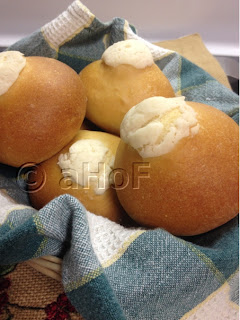 |
| Molletes |
What is a Mollete?
Mollete is pronounced "moh-YET-tay". The double "LL" in the middle is pronounced as "Y". Molletes, one of the "Panes de Manteca", or sweet/enriched breads, are small, individual sized rounded breads, vaguely sweet, and most often seen with a little mound of some sort of sugary substance stuck on the top. These little breads are excellent with beans and coffee for breakfast, or at any time of day. Great in the afternoon with coffee (or tea) as a snack, also. The bread is rich, soft inside, but with some substance. Aside from just eating them on the day they are made, once leftover, they become dry and crumbly. Guatemalans rarely waste foods, so once the bread becomes dried out, it becomes the basis for other things. |
| Molletes with egg and beans for breakfast |
 |
| Molletes, served |
I have been trying to make as many Guatemalan foods as possible, in order to get the photos to use in the cookbook/memoir I am still working on. I made the molletes just after Christmas, and have a bunch of them frozen. Eating them brings back a flood of taste memories, so I must have hit close to how the recipe should be made. Here is what I did:
Molletes
Makes 2 dozen
 BREAD: In a bowl, whisk together 2 cups of the flour with the sugar, yeast, baking powder and salt. Separately, combine the milk, eggs and vanilla. If the eggs do not make at least ½ cup, you may need a little more milk to mix the dough properly. Mix the lard or shortening into the dry ingredients briefly, then pour in the liquid mixture. Stir well, then add int he remaining flour and knead for about 15 or more minutes, or until the dough passes the windowpane test. For the windowpane test: take a small piece of the dough and stretch between the fingers until it will stretch thin enough to see light through (a "windowpane") without tearing. Grease a large bowl and scrape the dough into the bowl, turning once to grease both sides. Cover the bowl with plastic wrap and set in a warm place to rise until nearly doubled in bulk, about 1 to ½ hours.
BREAD: In a bowl, whisk together 2 cups of the flour with the sugar, yeast, baking powder and salt. Separately, combine the milk, eggs and vanilla. If the eggs do not make at least ½ cup, you may need a little more milk to mix the dough properly. Mix the lard or shortening into the dry ingredients briefly, then pour in the liquid mixture. Stir well, then add int he remaining flour and knead for about 15 or more minutes, or until the dough passes the windowpane test. For the windowpane test: take a small piece of the dough and stretch between the fingers until it will stretch thin enough to see light through (a "windowpane") without tearing. Grease a large bowl and scrape the dough into the bowl, turning once to grease both sides. Cover the bowl with plastic wrap and set in a warm place to rise until nearly doubled in bulk, about 1 to ½ hours.Turn the dough out onto a greased surface. Cut the dough into 24 equal balls, approximately 1½ ounces apiece. Form each portion of the dough into a nice, tight little ball and set well apart (about 3-inches between) on greased baking sheets.
 |
| Size of the dough balls; placement on baking sheet, and baked Molletes |
TOPPING: Mix together the three ingredients as for a streusel, though this will be far stickier. Moisten the top of each little bread ball with water, then place a scant ½ teaspoon of the topping mixture on each, spreading and flattening the mixture with moist fingers. Set the breads aside to rise in a warm place until nearly doubled in size, about 45 minutes to an hour. Preheat oven to 375 degrees. Bake the breads for about 12 minutes, to an internal temperature of 105 to 200 degrees, until golden, rotating the sheets once halfway through baking time for even browning.
My passion is teaching people how to create a harmony of flavors with their cooking, and passing along my love and joy of food, both simple or exotic, plain or fancy. I continue my journey in ethnic and domestic cuisines, continuing my journey to explore diverse culinary experiences and hopefully to start you on a journey of your own. Join me also at A Harmony of Flavors on Facebook, and Pinterest.

These are delicious! I had to make them for a project for Guatemalan desserts, and they came out amazing! Thank you for sharing this recipe.
ReplyDelete